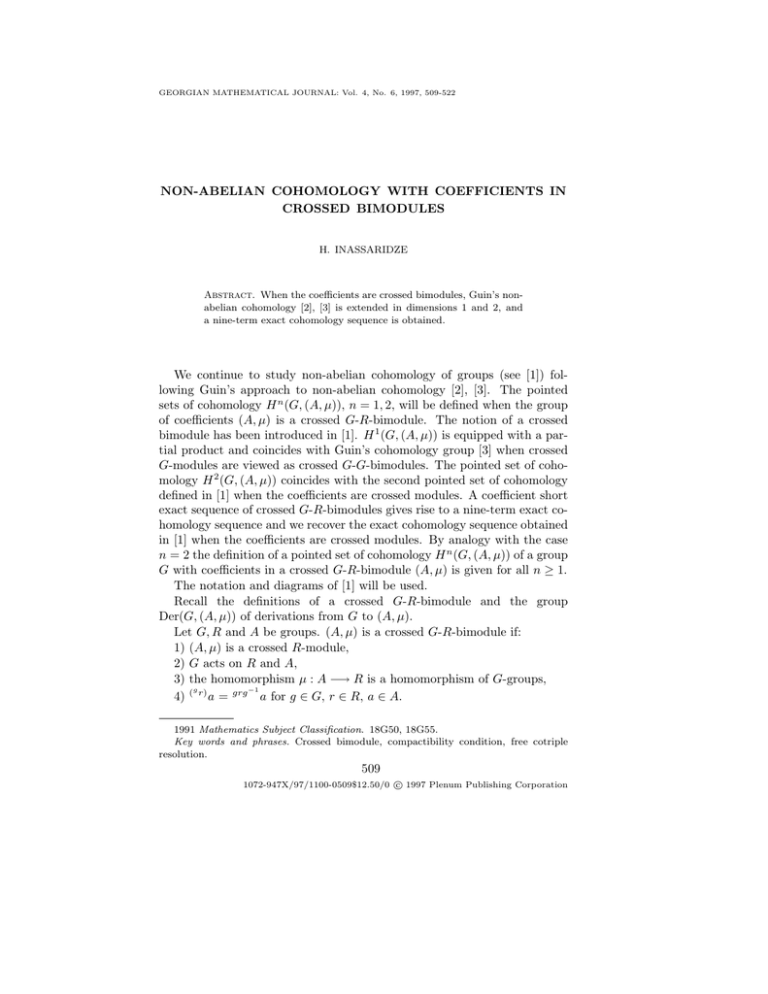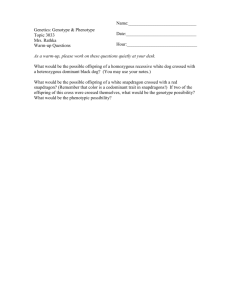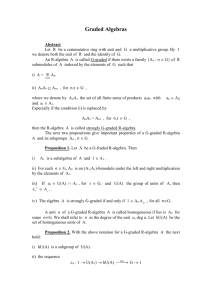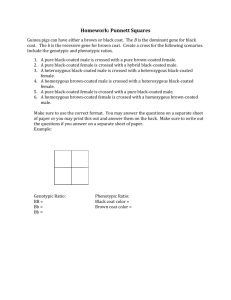NON-ABELIAN COHOMOLOGY WITH COEFFICIENTS IN CROSSED BIMODULES
advertisement

GEORGIAN MATHEMATICAL JOURNAL: Vol. 4, No. 6, 1997, 509-522
NON-ABELIAN COHOMOLOGY WITH COEFFICIENTS IN
CROSSED BIMODULES
H. INASSARIDZE
Abstract. When the coefficients are crossed bimodules, Guin’s nonabelian cohomology [2], [3] is extended in dimensions 1 and 2, and
a nine-term exact cohomology sequence is obtained.
We continue to study non-abelian cohomology of groups (see [1]) following Guin’s approach to non-abelian cohomology [2], [3]. The pointed
sets of cohomology H n (G, (A, µ)), n = 1, 2, will be defined when the group
of coefficients (A, µ) is a crossed G-R-bimodule. The notion of a crossed
bimodule has been introduced in [1]. H 1 (G, (A, µ)) is equipped with a partial product and coincides with Guin’s cohomology group [3] when crossed
G-modules are viewed as crossed G-G-bimodules. The pointed set of cohomology H 2 (G, (A, µ)) coincides with the second pointed set of cohomology
defined in [1] when the coefficients are crossed modules. A coefficient short
exact sequence of crossed G-R-bimodules gives rise to a nine-term exact cohomology sequence and we recover the exact cohomology sequence obtained
in [1] when the coefficients are crossed modules. By analogy with the case
n = 2 the definition of a pointed set of cohomology H n (G, (A, µ)) of a group
G with coefficients in a crossed G-R-bimodule (A, µ) is given for all n ≥ 1.
The notation and diagrams of [1] will be used.
Recall the definitions of a crossed G-R-bimodule and the group
Der(G, (A, µ)) of derivations from G to (A, µ).
Let G, R and A be groups. (A, µ) is a crossed G-R-bimodule if:
1) (A, µ) is a crossed R-module,
2) G acts on R and A,
3) the homomorphism µ : A −→ R is a homomorphism of G-groups,
−1
g
4) ( r) a = grg a for g ∈ G, r ∈ R, a ∈ A.
1991 Mathematics Subject Classification. 18G50, 18G55.
Key words and phrases. Crossed bimodule, compactibility condition, free cotriple
resolution.
509
c 1997 Plenum Publishing Corporation
1072-947X/97/1100-0509$12.50/0
510
H. INASSARIDZE
The group Der(G, (A, µ)) is defined as follows. It consists of pairs (α, r)
where α is a crossed homomorphism from G to A and r is an element of
R such that µα(x) = r x r−1 for all x ∈ G. A product in Der(G, (A, µ)) is
given by (α, r)(β, s) = (α ∗ β, rs) where (α ∗ β)(x) = x β(x)α(x), x ∈ G. For
any a ∈ A and (α, r) ∈ Der(G, (A, µ)) the following equality holds:
α(x) xr a =
rx
a α(x)
for all
x ∈ G.
Definition 1. Let (A, µ) be a crossed G-R-bimodule. It will be said that
a crossed homomorphism α : G −→ A satisfies condition (j) (resp. condition
(j0 )) if for c ∈ H 0 (G, R) (resp. if for c ∈ H 0 (G, R) such that there is b ∈ A
with µ(b) = c) there exists a ∈ A such that c α(x) = a−1 α(x) x a for x ∈ G
and µ(a) = 1. It will be said that an element (α, r) of Der(G, (A, µ)) satisfies
condition (j) (resp. condition (j0 )) if α satisfies this condition.
It is obvious that any element of the form (α, 1) satisfies condition (j0 ). If
(A, µ) is a crossed G-R-bimodule induced by a surjective homomorphism f :
G −→ R, then every element (α, r) ∈ Der(G, (A, µ)) such that α(ker f ) = 1
satisfies condition (j). In effect, for c ∈ Z(R) = H 0 (G, R) we have zx dx =
xd, x ∈ G, with f (d) = c and zx ∈ ker f . Thus, α(zx ) zx α(dx) = α(xd),
whence α(d) c α(x) = α(x) x α(d) and µα(d) = r f (d) r−1 f (d)−1 = 1.
Note that if (α, r) ∼ (α0 , r0 ) (see below) and (α, r) satisfies condition (j)
then (α0 , r0 ) satisfies condition (j) too when H 0 (G, R) ⊂ Z(R). In effect, we
have α0 (x) = b−1 α(x) x b, r0 = µ(b)−1 r t and c α(x) = a−1 α(x) x a, µ(a) = 1,
where c, t ∈ H 0 (G, R) ⊂ Z(R). Thus
α (x) = c b−1 c α(x) cx b = c b−1 a−1 α(x) x a cx b =
c 0
= c b−1 a−1 α(x) x (a c b) = c b−1 a−1 b α0 (x) x b−1 x (a c b) =
= c b−1 ba−1 α0 (x) x (ab−1 c b)
with µ(a b−1 c b)−1 = (µ(a) µ(b−1 ) µ(c b))−1 = µ(c b−1 ) µ(b) = c µ(b)−1 c−1
µ(b) = 1.
It is clear that if f : (A, µ) −→ (B, λ) is a homomorphism of crossed GR-bimodules and (α, r) ∈ Der(G, (A, µ)) satisfies condition (j), then (f α, r)
satisfies condition (j).
Let (A, µ) be a crossed G-R-bimodule. In the group Der(G, (A, µ)) we
introduce a relation ∼ defined as follows:
(
∃ a ∈ A : β(x) = a−1 α(x) x a,
(α, r) ∼ (β, s) ⇐⇒
.
s = µ(a)−1 r mod H 0 (G, R)
Later we shall need the following assertion:
If (A, µ) is a precrossed G-R-bimodule the equality
rx
a=
xr
a
(1)
NON-ABELIAN COHOMOLOGY OF GROUPS
511
holds for any x ∈ G, a ∈ A, r ∈ H 0 (G, R).
In effect,we have
rx
a=
xx−1 rx
−1
x(x
a =
r)
a =
xr
a.
Proposition 2. The relation ∼ is an equivalence. Assume H 0 (G, R) is a
normal subgroup of R; then the group Der(G, (A, µ)) induces on
Der(G, (A, µ))/ ∼ a partial product defined by
[(α, 1)][(β, s)] = [(α ∗ β, s)]
if [(β, s)] contains an element satisfying condition (j0 ), and by
[(α, r)][(β, s)] = [(α ∗ β, rs)]
if [(β, s)] contains an element satisfying condition (j).
Proof. If (α, r) ∼ (α0 , r0 ), i.e., α0 (x) = a−1 α(x) x a, x ∈ G, and r0 =
µ(a)−1 rz, z ∈ H 0 (G, R), then α(x) = a α(x) x a−1 and r = µ(a) r0 z −1 ,
z −1 ∈ H 0 (G, R). Thus, (α0 , r0 ) ∼ (α, r).
If (α, r) ∼ (α0 , r0 ) and (α0 , r0 ) ∼ (α00 , r00 ) we have
α0 (x) = a−1 α(x) x a,
r0 = µ(a)−1 rz,
α00 (x) = b−1 α0 (x) x b,
r00 = µ(b)−1 r0 z 0 ,
where z, z 0 ∈ H 0 (G, R). This implies (α, r) ∼ (α00 , r00 ) and the relation ∼ is
an equivalence.
It is clear that if (α, r) ∈ Der(G, (A, µ)) and c ∈ H 0 (G, R) then (α, r) ∼
(α, rc).
We have yet to show the correctness of the partial product.
Let (α, 1) ∼ (α0 , 1), (β, s) ∼ (β 0 , s0 ) and (β, s) satisfy condition (j0 ). We
will prove that (α, 1)(β, s) ∼ (α0 , 1)(β 0 , s0 ). One has
α0 (x) = a−1 α(x) x a,
−1
1 = µ(a)
z,
0
x ∈ G,
z ∈ H (G, R),
and
β 0 (x) = b−1 β(x) x b,
s0 = µ(b)−1 sz 0 ,
x ∈ G,
z 0 ∈ H 0 (G, R).
Then β 0 (x)α0 (x) = b−1 β(x) x ba−1 α(x) x a = b−1 β(x)a−1 α(x) x a x b = b−1 a−1
µ(a)
β(x)α(x) x a x b = b−1 a−1 d−1 β(x)α(x) x (dab) and s0 = µ(b)−1 µ(a)−1 zsz 0 =
−1 −1 −1
µ(b a d ) sz 00 z 0 where β(x) = d−1 β(x) x d, µ(d) = 1 and z 00 ∈ H 0 (G, R).
Therefore (α, 1)(β, s) ∼ (α0 , 1)(β 0 , s0 ).
It is clear that the set of all elements of the form [(α, 1)] forms an abelian
group under this product.
512
H. INASSARIDZE
Finally, we will prove that if (α, r) ∼ (α0 , r0 ), (β, s) ∼ (β 0 , s0 ) and (β, s)
satisfies condition (j) then (α, r)(β, s) ∼ (α0 , r0 )(β 0 , s0 ) and we check Guin’s
proof [3] in our case.
We first prove that
(α, r)(β, s) ∼ (α, rc)(β, s)
for c ∈ H 0 (G, R).
Using condition (j) and equality (1) of [3] one gets
rc
β(x)α(x) = r (a−1 β(x) x a) α(x) = r a−1 r β(x) rx a α(x) =
= r a−1 r β(x)α(x) rx a.
Since µ(r a)−1 = (r µ(a) r−1 )−1 = 1, one has rcs = µ (r a)−1 rsc0 with
c ∈ H 0 (G, R). Therefore, (α, r)(β, s) ∼ (α, rc)(β, s).
Further,we have
0
α0 (x) = b−1 α(x) x b,
r0 = µ(b)−1 rz,
and β 0 (x) = d−1 β(x) x d, s0 = µ(d)−1 st with z, t ∈ H 0 (G, R).
Put
(α, rz)(β, s) = (γ, rzs),
where γ(x) = rz β(x)α(x), x ∈ G, and (α0 , r0 )(β 0 , s0 ) = (γ 0 , r0 s0 ), where
0
γ 0 (x) = r β 0 (x)α0 (x), x ∈ G.
We will show that
(α, rz)(β, s) ∼ (α0 , r0 )(β 0 , s0 ).
Using (1) and equality (1) of [1] one has
γ 0 (x) =
=
µ(b)−1 r·z −1
= b−1 r·z d−1
d
rz
r0
(d−1 β(x) x d) b−1 α(x) x b =
µ(b)−1 rz
β(x) µ(b)
−1
rzx
d b−1 α(x) x b =
β(x) r·x (z d) α(x) x b = b−1 r·z d−1
r·z
β(x)α(x) xrz d x b,
and µ(r·z d b)−1 = µ(b)−1 rz µ(d)−1 z −1 r−1 = r0 s0 t−1 s−1 z −1 r−1 , r0 s0 =
µ(r·z d b)−1 rzst with t ∈ H 0 (G, R).
Therefore (α, rz)(β, s) ∼ (α0 , r0 )(β 0 , s0 ), whence (α, r)(β, s) ∼ (α0 , r0 )
0 0
(β , s ).
Definition 3. Let (A, µ) be a crossed G-R-bimodule. One denotes by
H 1 (G, (A, µ)) the quotient set Der(G, (A, µ))/ ∼ equipped with the aforementioned partial product and it will be called the first set of cohomology of
G with coefficients in the crossed G-R-bimodule (A, µ).
NON-ABELIAN COHOMOLOGY OF GROUPS
513
If (A, µ) is a crossed G-module viewed as a crossed G-G-bimodule then
H 0 (G, G) = Z(G) and for (α, g) ∈ DerG (G, A) = Der(G, (A, µ)) and c ∈
Z(G) the equality α(cx) = α(xc), x ∈ G, implies
α(c) c α(x) = α(x) x α(c),
whence c α(x) = α(c)−1 α(x) x α(c) and µ(α(c)) = gcg −1 c−1 = 1. Therefore
every element of DerG (G, A) satisfies condition (j). It follows that if (A, µ)
is a crossed G-module we recover the group H 1 (G, A) defined by Guin [3].
It is clear that the map H 1 (G, A) −→ H 1 (G, (A, 1)) given by [α] 7−→
[(α, 1)] is an isomorphism where (A, 1) is a crossed G-R-bimodule.
Proposition 4. Let (A, µ) be a crossed G-R-bimodule and assume
H 0 (G, R) is a normal subgroup of R. If (α, r) and (β, s) satisfy condition
(j) then (α, r)(β, s) and (α, r)−1 satisfy condition (j).
Proof. Let c ∈ H 0 (G, R). Then c α(x) = b−1 α(x) x b and µ(b) = 1. Since
H 0 (G, R) is a normal subgroup of R, there is c0 ∈ H 0 (G, R) such that cr =
0
rc0 . For c0 we have c β(x) = d−1 β(x) x d and µ(d) = 1. Put (α, r)(β, s) =
(γ, rs). Then
c
γ(x) =
cr
β(x) c α(x) = r d−1 r β(x) rx d b−1 α(x) x b =
= r d−1 b−1 r β(x)α(x) x (b r d)
with µ(b r d) = µ(b) r µ(d) r−1 = 1. Thus, (γ, rs) satisfies condition (j). Put
−1
(α, r)−1 = (α, r−1 ) where α(x) = r α(x)−1 , x ∈ G. If c ∈ H 0 (G, R) one
has
−1
−1 0
−1
c
α(x) = cr α(x)−1 = r c α(x)−1 = r (x a−1 α(x)−1 a),
where cr−1 = r−1 c0 , c0 ∈ H 0 (G, R) and
Hence
c
α(x) =
=
r −1 x −1 r −1
a
r
−1
ar
−1
α(x)−1 r
α(x)−1 x (r
−1
−1
c0
a=
α(x) = a−1 α(x)−1 x a, µ(a) = 1.
r −1
α(x)−1 xr
−1
a−1 r
−1
a=
a−1 )
−1
with µ(r a−1 ) = r−1 µ(a−1 ) r = 1.
Therefore, (α, r−1 ) satisfies condition (j).
Corollary 5. The subset of H 1 (G, (A, µ)) of all equivalence classes containing an element with condition (j) forms a group if H 0 (G, R) is a normal
subgroup of R.
Proposition 6. Let (A, µ) be a crossed G-R-bimodule such that H 0 (G,R)
is a normal subgroup of R. If there is a map η : H 0 (G, R) −→ Z(G) such
that Im η acts trivially on R and η(r) a = r a, a ∈ A, then H 1 (G, (A, µ)) is
a group.
514
H. INASSARIDZE
Proof. We have to show that every element (α, r) ∈ Der(G, (A, µ)) satisfies
condition (j). If c ∈ H 0 (G, R) take η(c) = d ∈ Z(G). Then α(dx) = α(xd)
and α(d) d α(x) = α(x) x α(d). Thus c α(x) = α(d)−1 α(x) x α(d) and µα(d) =
r d r−1 = rr−1 = 1.
Corollary 7. Let (A, µ) be either a crossed G-R-bimodule such that
H 0 (G, R) is a normal subgroup of R trivially acting on A or induced by
a surjective homomorphism f : G −→ R such that f (Z(G)) = Z(R). Then
H 1 (G, (A, µ)) is a group.
Proof. In the first case take η as the trivial map. In the second case take a
map η : Z(R) −→ Z(G) such that f η = 1Z(R) .
If f : (A, µ) −→ (B, λ) is a homomorphism of crossed G-R-bimodules
then f induces a natural map
f 1 : H 1 (G, (A, µ)) −→ H 1 (G, (B, λ))
which is a homomorphism in the following sense:
if xy is defined for x, y ∈ H 1 (G, (A, µ)) then f 1 (x)f 1 (y) is defined and
1
f (xy) = f 1 (x)f 1 (y).
The above defined action of G on Der(G, (A, µ)) induces an action of G
on H 1 (G, (A, µ)) given by
g
[(α, r)] = [g (α, r)],
g ∈ G.
We have to show that if (α, r) ∼ (α0 , r0 ) then g (α, r) ∼ g (α0 , r0 ). In effect,
since
α0 (x) = a−1 α(x) x a, x ∈ G,
this implies
α0 (g
−1
Thus
g
α 0 (g
x) = a−1 α(g
−1
−1
x) g
x) = g a−1 g α(g
−1
−1
xg
a,
x ∈ G.
x) xg a,
x ∈ G.
We also have r0 = µ(a)−1 rz, z ∈ H 0 (G, R), whence g r0 = g µ(a−1 ) g r g z =
µ(g a)−1 g r g z. Therefore g (α, r) ∼ g (α0 , r0 ).
In what follows if f is a map from a group G to a group G0 then f −1 :
G −→ G0 denotes a map given by f −1 (x) = f (x)−1 .
Let (A, µ) be a crossed G-R-bimodule. The definition of H 2 (G, (A, µ))
is similar to the case of (A, µ) being a crossed G-module (see [1]).
Consider diagram (4) of [1] and the group Der(M, (A, µ)) where (A, µ)
is viewed as a crossed M -R-bimodule induced by τ l0 and a crossed F -Rf1 (M, (A, µ)) be the subset of Der(M, (A, µ))
bimodule induced by τ . Let Z
consisting of elements of the form (α, 1).
Define, on Ze1 (M, (A, µ)), relation
(α0 , 1) ∼ (α, 1) ⇐⇒ (β, h) ∈ Der(F, (A, µ))
NON-ABELIAN COHOMOLOGY OF GROUPS
515
such that
(α0 , 1) = (βl0 , h)(α, 1)(βl1 , h)−1
in the group Der(M, (A, µ)).
Definition 8. Let (A, µ) be a crossed G-R-bimodule. The relation ∼
e1 (M,(A, µ))
is an equivalence. Denote by H 2 (G,(A, µ)) the quotient set Z
/ ∼. It will be called the second set of cohomology of G with coefficients in
the crossed G-R-bimodule (A, µ).
It can be proved (as for a crossed G-module (A, µ) (see Proposition 8 [1]))
f1 (M, (A, µ)) / ∼ is independent of diagram (4) of [1] and is unique
that Z
up to bijection.
Let (A, µ) be a crossed G-R-bimodule. Then there is a canonical map
ϑ0 : H 2 (G, ker µ) −→ H 2 (G, (A, µ))
defined by the composite
ϑ−1
[E] 7−→ [α] 7−→ [(α, 1)].
This map is surjective and was defined when (A, µ) is a crossed G-module
[3].
Proposition 9. Let (A, µ) be a crossed G-R-bimodule. There is an action of G on H 2 (G, (A, µ)) such that Z(G) acts trivially. If R acts on G and
satisfies the compatibility condition (3) of [1] then there is also an action of
R on H 2 (G, (A, µ)).
Proof. The action of G on H 2 (G, (A, µ)) is defined exactly in the same
manner as for a crossed G-module (A, µ) (see Proposition 12 [1]). The
action of R is defined similarly. Namely, we have an action of R on MG
given by
r
0
0
|)
| ) = (|r g1 | · · · |r gn | , |r g10 | · · · |r gm
(|g1 | · · · |gn | , |g10 | · · · |gm
and one gets an action of R on Der(MG , (A, µ)) defined by
r
α,r s),
(α, s) = (e
−1
where α
e(m) = r α(r m), r ∈ R, m ∈ MG . Define r [(α, 1)] = [r (α, 1)],
r ∈ R. If (α, 1) ∼ (α0 , 1) it is easy to see that r (α, 1) ∼ r (α0 , 1).
Let (A, µ) be a crossed G-R-bimodule. Using (1) it can easily be shown
that there is an action of H 0 (G, R) on H 2 (G, ker µ) given by
r
[α] = [r α],
r ∈ H 0 (G, R),
where α : MG −→ ker µ is a crossed homomorphism under the action of G
on A (see diagram (5) of [1]) such that α(∆) = 1.
516
H. INASSARIDZE
If this action of H 0 (G, R) is trivial and Der(FG ,(A, µ)) = IDer(FG ,(A, µ))
then the map
ϑ0 : H 2 (G, ker µ) −→ H 2 (G, (A, µ))
is a bijection.
Let
ϕ
ψ
1 −→ (A, 1) −→ (B, µ) −→ (C, λ) −→ 1
(2)
be an exact sequence of crossed G-R-bimodules. If the action of H 0 (G, R)
on H 2 (G, A) is trivial then there is an action of H 1 (G, (C, λ)) on H 2 (G, A)
given by
[(α,r)]
[γ] = [r γ].
We have to show that r γ is a crossed homomorphism and the correctness
of the action.
Consider the diagram
l0
−→
−→
MG
l1
ϕ
A
−→
FG
B
τ
G
−→
ψ
−→
G
(3)
↓α
C
There is a crossed homomorphism β : FG −→ B such that ψβ = ατG . Take
the product
γ , 1)
(βl0 , r)(ϕγ, 1)(βl0 , r)−1 = (e
in the group Der(MG , (B, µ)). Then γ
e(x) = β(x)−1 r ϕγ(x) β(x) = r ϕγ(x),
r
x ∈ M . Therefore γ : MG −→ A is a crossed homomorphism such that
r
γ(∆) = 1.
If (α0 , r0 ) ∈ [(α, r)] ∈ H 1 (G, (C, λ)), i.e., (α, r) ∼ (α0 , r0 ), then
α0 (x) = c−1 α(x) x c and r0 = λ(c)−1 rt,
where t ∈ H 0 (G, R). It follows that
0
ϕ(r γ(x)) =
r0
=b
where ψ(b) = c.
Hence we have
ϕγ(x) =
−1 r·t
λ(c)−1 rt
ϕγ(x) b =
ϕγ(x) =
r·t
µ(b)−1 rt
r·t
ϕγ(x) =
ϕγ(x) = ϕ( γ(x)),
x ∈ MG ,
0
[r γ] = [rt γ] = [r γ]
proving the correctness of the action.
Using diagram (3) for the exact sequence (2) one defines a connecting
map
δ 1 : H 1 (G, (C, λ)) −→ H 2 (G, A)
as follows.
NON-ABELIAN COHOMOLOGY OF GROUPS
517
For [(α, r)] ∈ H 1 (G, (C, λ)) take a crossed homomorphism β : FG −→ B
such that ψβ = α τG . Thus there is a crossed homomorphism γ : MG −→ A
such that
ϕγ = (βl1 )−1 βl0 .
It is clear that γ(∆) = 1. Define
δ 1 ([(α, r)]) = [γ].
We must prove the correctness of δ 1 . If β 0 : FG −→ B with ψβ 0 = ατ ,
then ψβ 0 = ψβ. Thus there is a crossed homomorphism σ : FG −→ A such
that β 0 = βϕσ. Then we have
ϕγ 0 = (β 0 l1 )−1 β 0 l0 = (βϕσ)l1 −1 (βϕσ)l0 = ϕσl1−1 βl1−1 βl0 ϕσl0 =
= βl1−1 βl0 ϕσl1−1 ϕσl0 = ϕ(γσl1−1 σl0 ).
Hence [γ 0 ] = [γ].
If (α, r) ∼ (α0 , r0 ) then
α0 (y) = c−1 α(y) y c,
0
−1
r = λ(c)
rt,
Take β 0 : FG −→ B such that
c ∈ C,
0
y ∈ M,
t ∈ H (G, R).
β 0 (x) = b−1 β(x) x b
with ψ(b) = c where ψβ = ατ . Then (β 0 l1−1 β 0 l0 )(y) = β 0 (x2 )−1 β 0 (x1 )
where y = (x1 , x2 ) ∈ MG . Hence ϕγ 0 (y) = (β 0 l1−1 β 0 l0 )(y) = (b−1 β(x2 )
x2 −1 −1
b) b β(x1 ) x1 b = x2 b−1 β(x2 )−1 β(x1 ) x1 b = β(x2 )−1 β(x1 ) = ϕγ(y).
Whence γ 0 = γ.
For any exact sequence (2) of crossed G-R-bimodules there is also an
action of Der(F0 , (C, λ)) on H 3 (G, A) defined as follows:
(α,r)
[f ] = [r f ],
where f : F2 −→ A is a crossed homomorphism with
3
Q
i=0
(f li2 τ3 ) = 1 where
= (−1)i (see diagram (7) of [1]) and (α, r) ∈ Der(F0 , (C, λ)). The correctness of this action is proved similarly to the case of a short exact sequence
of crossed G-modules (see [1]).
If either the aforementioned action of Der(F0 , (C, λ)) on H 3 (G, A) is trivial or Der(F0 , (C, λ)) = IDer(F0 , (C, λ)) and H 0 (G, R) acts trivially on
H 2 (G, ker λ), then a connecting map
δ 2 : H 2 (G, (C, λ)) −→ H 3 (G, A)
is defined by
δ 2 ([(α, 1)]) = [γ],
g 0 , (C, λ)),
(α, 1) ∈ Der(M
518
H. INASSARIDZE
where ϕγ = βτ2 with β =
2
Q
i=0
(βli1 ) , = (−1)i , and ψβ = ατ1 (see diagram
(7) of [1]). The correctness of δ 2 is proved similarly to the case of crossed
G-modules [1], and if (2) is an exact sequence of crossed G-modules we
recover the above-defined connecting map δ 2 : H 2 (G, C) −→ H 3 (G, A).
Theorem 10. Let (2) be an exact sequence of crossed G-R-bimodules.
Then there is an exact sequence
ψ0
ϕ0
δ0
1 −→ H 0 (G, A) −→ H 0 (G, B) −→ H 0 (G, C) −→
ϕ1
δ0
ψ1
δ1
ϕ2
−→ H 1 (G, A) −→ H 1 (G, (B, µ)) −→ H 1 (G, (C, λ)) −→ H 2 (G, A) −→
ϕ2
ψ2
−→ H 2 (G, (B, µ)) −→ H 2 (G, (C, λ)),
where ϕ0 , ψ 0 , δ 0 , ϕ1 are homomorphisms. If H 0 (G, R) is a normal subgroup
of R, then ψ 1 and δ 1 are also homomorphisms. If in addition H 0 (G, R) acts
trivially on H 2 (G, A), then δ 1 is a crossed homomorphism under the action
of H 1 (G, (C, λ)) on H 2 (G, A) induced by the action of R on A. Moreover,
if either the action of Der(F0 , (C, λ)) on H 3 (G, A) is trivial (in particular if
R acts trivially on A) or Der(F0 , (C, λ)) = IDer(F0 , (C, λ)) and H 0 (G, R)
acts trivially on H 2 (G, ker λ) then the sequence
ψ2
δ2
H 2 (G, (B, µ)) −→ H 2 (G, (C, λ)) −→ H 3 (G, A)
is exact.
Proof. The exactness of the sequence
ϕ0
ψ0
δ0
1 −→ H 0 (G, A) −→ H 0 (G, B) −→ H 0 (G, C) −→ H 1 (G, A)
is known [4].
If c ∈ H 0 (G, C) then δ 0 (c) = [α] with α(x) = ϕ−1 (b−1 x b), x ∈ G and
ψ(b) = c. It follows that (α0 , 1) ∼ (ϕα, 1) where α0 is the trivial map, since
ϕα(x) = b−1 α0 x b,
x ∈ G,
and µ(b) ∈ H 0 (G, R) because µ(b) = λψ(b) = λ(c) and x λ(c) = λ(x c) =
λ(c), x ∈ G. Therefore Im δ 0 ⊂ ker ϕ1 .
Let [α] ∈ H 1 (G, A) such that (α0 , 1) ∼ (ϕα, 1). Then ϕα(x) = b−1 x b,
x ∈ G and µ(b) ∈ H 0 (G, R). We have ψ(b−1 x b) = ψϕα(x) = 1. Thus
ψ(b) = ψ(x b) = x ψ(b), whence ψ(b) ∈ H 0 (G, C). It is clear that δ 0 (ψ(b)) =
[α]. Therefore ker ϕ1 ⊂ Im δ 0 .
Clearly, ψ 1 ϕ1 is the trivial map. Let [(α, r)] ∈ H 1 (G, (B, µ)) such that
(α0 , 1) ∼ (ϕα, 1). Then ψα(x) = c−1 x c, c ∈ C, and r = λ(c)−1 t, t ∈
H 0 (G, R). Let ψ(b) = c. Then µ(b) = λ(c) and r = µ(b)−1 t. Take α
e(x) =
NON-ABELIAN COHOMOLOGY OF GROUPS
519
b α(x) x b−1 , x ∈ G. Since ψ α
e(x) = 1, x ∈ G, one has ϕ−1 α
e : G −→ A and
1
r)
∼
(e
ϕ
(α,
α, 1). Therefore ([ϕ−1 α
e]) = [(α, r)].
Let [(α, r)] ∈ H 1 (G, (B, µ)). Then ψ 1 ([(α, r)]) = [(ψα, r)]. Consider
diagram (5) of [1] and take α τG : FG −→ B. Then ϕγ = (ατG l1 )−1 ατG l0
and δ 1 ψ 1 ([(α, r)]) = [γ]. But γ = α0 is the trivial map, since ατG l0 = ατG l1 .
Therefore Im ψ 1 ⊂ ker δ 1 .
Let [(α, r)] ∈ H 1 (G, (C, λ)) such that δ 1 ([(α, r)]) = 1. If β : FG −→ B is
a crossed homomorphism such that ψβ = ατG then δ 1 ([(α, r)]) = [γ], where
ϕγ = (βl1 )−1 βl0 . Thus there is a crossed homomorphism η: FG −→ A such
that γ = (ηl1 )−1 ηl0 . Hence we have
(βl1 )−1 βl0 = (ϕηl1 )−1 ϕηl0 ,
(ϕη −1 β)l0 = (ϕη −1 β)l1 .
Thus there is a crossed homomorphism α : G −→ B such that (ϕη)−1 β =
ατG . We have µβ(x) = λψβ(x) = λατG (x) = r τG (x) r−1 , whence (β, r) ∈
Der(FG , (B, µ)) and (α, r) ∈ Der(G, (B, µ)). Evidently, ψ 1 ([(α, r)]) = [(α, r)].
The rest of the proof repeats with minor modifications the proof of the
exactness of the cohomology sequence for a coefficient short exact sequence
of crossed G-modules (see Theorems 13 and 15 of [1]).
It is clear that when (2) is an exact sequence of crossed G-modules,
Theorem 10 implies Theorems 13 and 15 of [1].
By analogy with the case n = 1 we propose the following definition of the
pointed set of cohomology H n+1 (G, (A, µ)) of a group G with coefficients
in a crossed G-R-bimodule (A, µ) (in particular, in crossed G-modules) for
all n ≥ 1.
Let (A, µ) be a crossed G-R-bimodule. Consider diagram (7) of [1] and
the group Der(Fn , (A, µ)), n ≥ 1, where (A, µ) is viewed as a crossed Fn R-bimodule induced by τ0 ∂01 ∂02 · · · ∂0n−1 ∂0n with ∂0i = l0i−1 τi , i = 1, . . . , n.
f1 (Fn , (A, µ)) the subset of Der(Fn , (A, µ)) consisting of all eleDenote by Z
ments of the form (α, 1) satisfying the condition
n+1
Y
(α∂jn+1 ) = 1,
= (−1)i .
j=0
f1 (Fn , (A, µ))
Note that since µα(x) = 1, x ∈ Fn , we have α(Fn ) ⊂ Z(A). In Z
0
we introduce a relation ∼ as follows: (α , 1) ∼ (α, 1) if there is an element
(β, h) ∈ Der(Fn−1 , (A, µ)) such that
α0 (x) = h α(x)
n
Y
(β∂in (x)) ,
i=0
x ∈ Fn ,
(4)
520
H. INASSARIDZE
where = (−1)i . Since the homomorphism τ0 ∂i1n ∂i2n−1 · · · ∂in−1
∂in1 does not
2
depend on the sequence (i1 , i2 , . . . , in−1 , in ), we have
β∂jn (x)(β∂ln (x))−1 = (β∂ln (x))−1 β∂jn (x) ∈ ker µ,
for j even and l odd. It follows that the product
n
Q
i=0
x ∈ Fn ,
(β∂in (x)) in (4) does
not depend on the order of the factors. Note that if n is even then β(Fn ) ⊂
ker µ ⊂ Z(A).
Similarly to the case n = 1 it can be shown that the relation ∼ is an
f1 (Fn , (A, µ))/ ∼ is independent of diagram
equivalence, the quotient set Z
(7) of [1] (for instance, we can take the free cotriple resolution of the group
G), and there is a surjective map
f1 (Fn , (A, µ))/ ∼,
ϑ0n : H n+1 (G, ker µ) −→ Z
n ≥ 1,
given by [α] 7−→ [(α, 1)] which is bijective if (A, µ) is a crossed G-G-bimodule
and either µ is the trivial map or n is even.
Definition 11. Let (A, µ) be a crossed G-R-bimodule. Define
f1 (Fn , (A, µ))/ ∼,
H n+1 (G, (A, µ)) = Z
n ≥ 1.
It is clear that for n = 1 we recover the second set of cohomology of G
with coefficients in (A, µ).
Remark 1. Using the above-defined cohomology with coefficients in
crossed bimodules it is possible to define a cohomology H n (G, A), n ≤ 2, of
a group G with coefficients in a G-group A.
Consider the quotient group A = A/Z(A) and define an action of A on
A and an action of G on A as follows:
[a0 ]
0
a = a a, a, a0 ∈ A,
g
[a] = [g a], g ∈ G, a ∈ A.
Let µA : A −→ A be the canonical homomorphism. Then (A, µA ) is a
crossed G-A-bimodule and we define
H n (G, A) = H n (G, (A, µA )),
n ≤ 2.
For n = 1 this cohomology differs from the pointed set of cohomology
defined in [4]. If
ϕ
ψ
1 −→ A −→ B −→ C −→ 1
NON-ABELIAN COHOMOLOGY OF GROUPS
521
is a central extension of G-groups then ψ induces an isomorphism ϑ :
≈
B/Z(B) −→ C/ψ(Z(B)) and one gets a short exact sequence of crossed
G-B-bimodules
ϕ
ψ
1 −→ (A, 1) −→ (B, µB ) −→ (C, µC ) −→ 1,
where µC is the composite of the canonical map τ : C −→ C/ψ(Z(B))
and the isomorphism ϑ−1 . Since B acts trivially on A, from Theorem 10
immediately follows the exact cohomology sequence
ϕ0
ψ0
ϕ1
δ0
1 −→ H 0 (G, A) −→ H 0 (G, B) −→ H 0 (G, C) −→ H 1 (G, A) −→
ϕ1
ψ1
ϕ2
δ1
ψ2
−→ H 1 (G, B) −→ H 1 (G, (C, µC )) −→ H 2 (G, A) −→ H 2 (G, B) −→
ψ2
δ2
−→ H 2 (G, (C, µC )) −→ H 3 (G, A).
Remark 2. As for the case n = 2 (see Remark of [1]) it is possible to
give an alternative more non-abelian definition of the third cohomology
3
H (G, (A, µ)) of G with coefficients in a crossed G-R-bimodule (A, µ). To
this end consider the commutative diagram
1
MG
ϕ0
−→
−→
ϕ1
QG
q1 ↓↓ q0
2
F (G)
↓ τF (G)
F (G)
ηG
−→
F (τG )
−→
τ
G
−→
MG
l1 ↓↓ l0
F (G)
↓ τG
G
,
where F (G) = FG , F 2 (G) = F (F (G)), τG and τF (G) are canonical surjec1
tions, ηG is induced by F (τG ), and (MG , l0 , l1 ), (QG , q0 , q1 ), (MG
, ϕ0 , ϕ1 ) are
the simplicial kernels of τG , τF (G) and ηG , respectively. It is clear that (A, µ)
g G , (A, µ)) be the
is a crossed QG -G-bimodule induced by τG l0 ηG . Let Der(Q
subgroup of Der(QG , (A, µ)) consisting of elements (β, g) such that β(∆Q ) =
f1 (M 1 , (A, µ)) of all
1, where ∆Q = {(x, x), x ∈ F 2 (G)}. Consider the set Z
G
1
crossed homomorphisms α : MG −→ A with α(∆) = 1 where ∆ = {(y, y), y ∈
1
f1 (M 1 , (A, µ)), a
QG } and MG
acts on A via τG l0 ηG ϕ0 . Introduce, in Z
G
relation of equivalence as follows:
g G , (A, µ))
α0 ∼ α if ∃(β, g) ∈ Der(Q
1
such that α0 (x) = βϕ1 (x)−1 α(x) βϕ0 (x), x ∈ MG
. Define H 3 (G, (A, µ)) =
1
f
3
1
Z (MG , (A, µ))/ ∼. Then H (G, (A, µ)) is a covariant functor from the
category of crossed G-R-bimodules to the category of pointed sets. It can
be proved that H 3 (G, (A, 1)) is isomorphic to the classical third cohomology
group H 3 (G, A) if A is a G-module.
522
H. INASSARIDZE
Acknowledgement
The research described in this publication was made possible in part by
Grant MXH200 from the International Science Foundation and by INTAS
Grant No 93-2618.
References
1. H. Inassaridze, Non-abelian cohomology of groups. Georgian Math.
J. 4(1997), No. 4, 313–332.
2. D. Guin, Cohomologie et homologie non abeliennes des groupes. C.
R. Acad. Sci. Paris 301(1985), Serie l,No. 7, 337–340.
3. D. Guin, Cohomologie et homologie non abeliennes des groupes. J.
Pure Appl. Algebra 50(1988) 109–137.
4. J.-P. Serre, Cohomologie galoisienne. Lecture Notes in Math. 5,
Springer, Berlin, 1964.
(Received 02.06.1995)
Author’s address:
A. Razmadze Mathematical Institute
Georgian Academy of Sciences
1, M. Aleksidze St., Tbilisi 380093
Georgia







